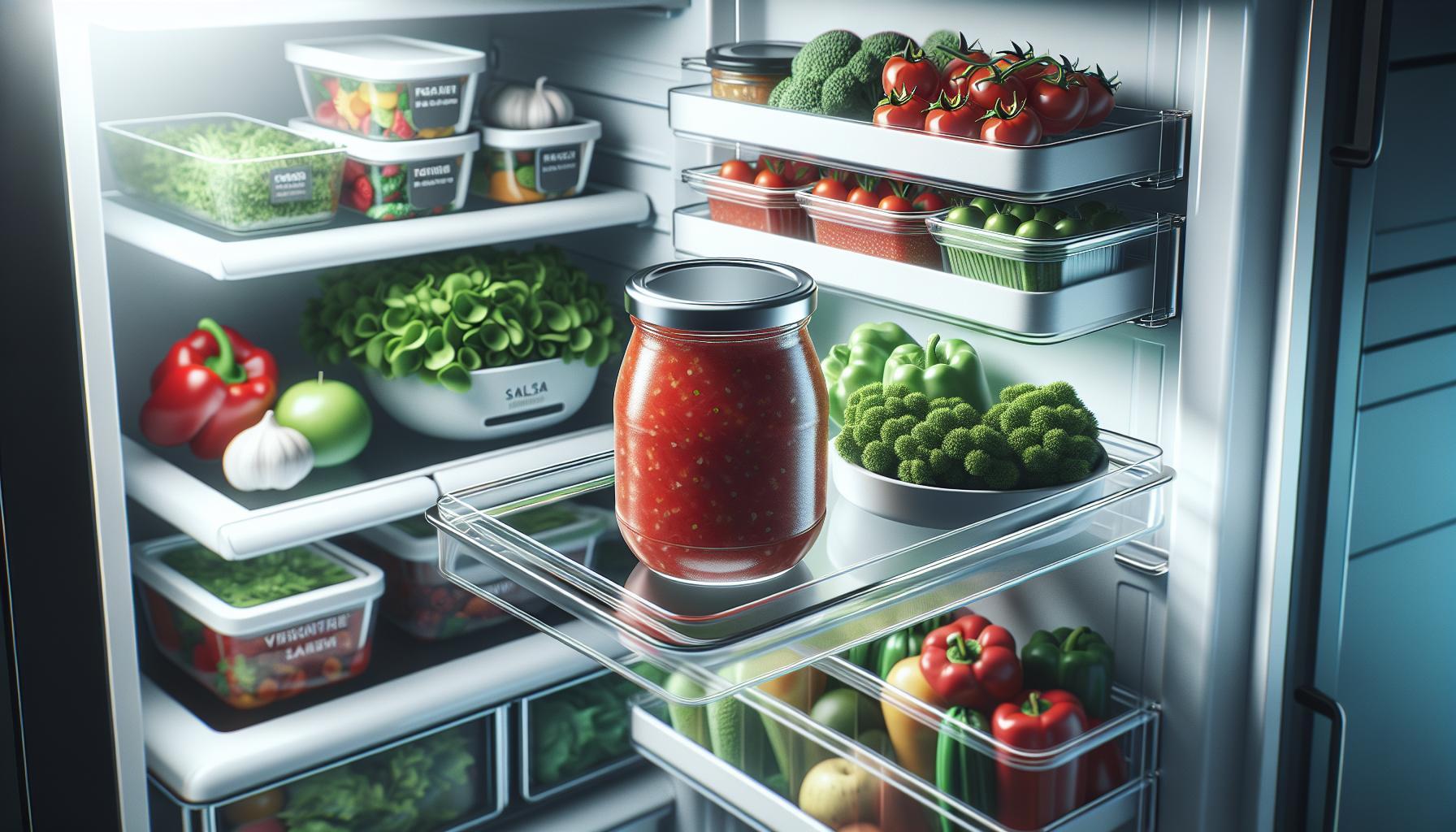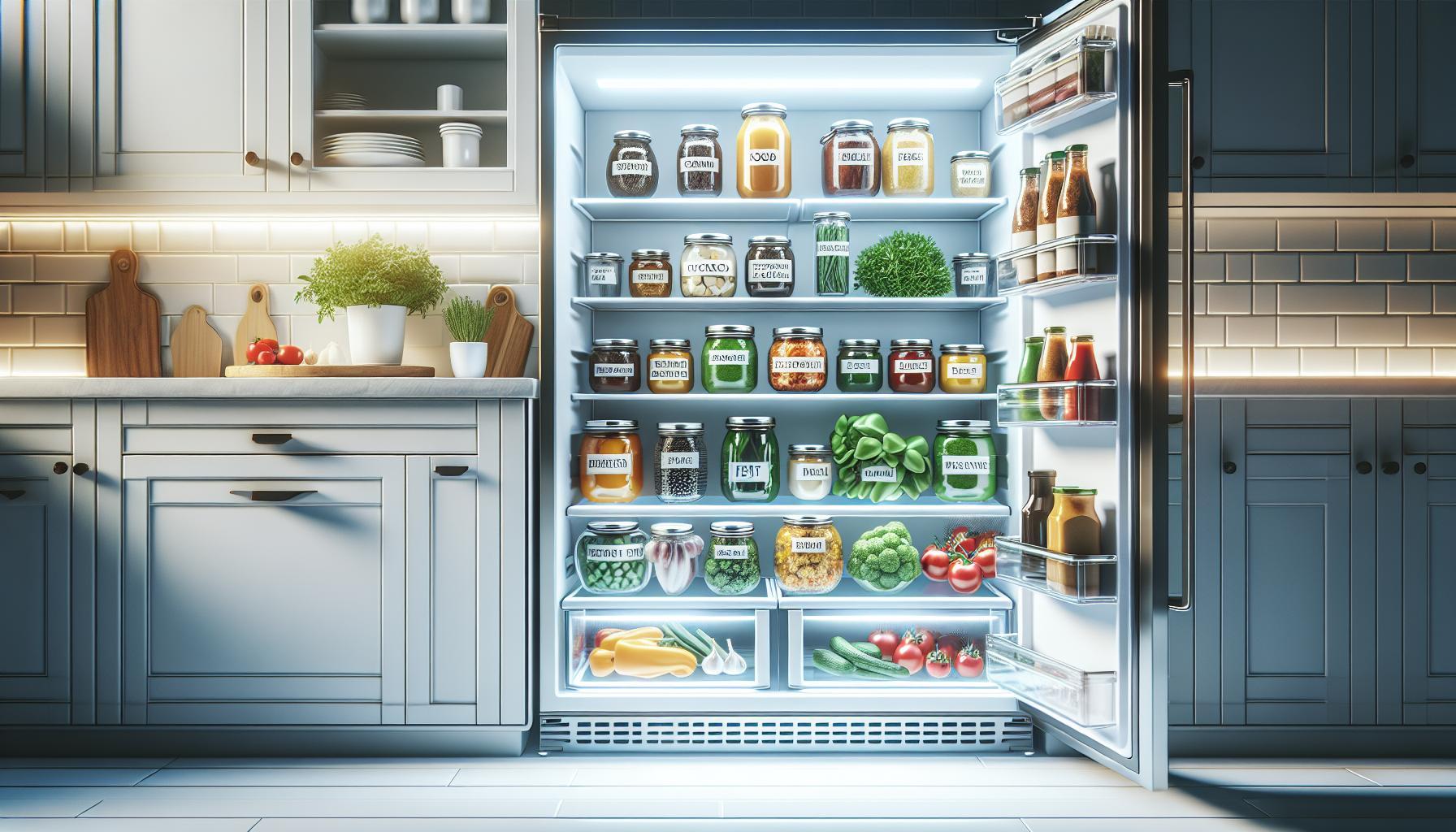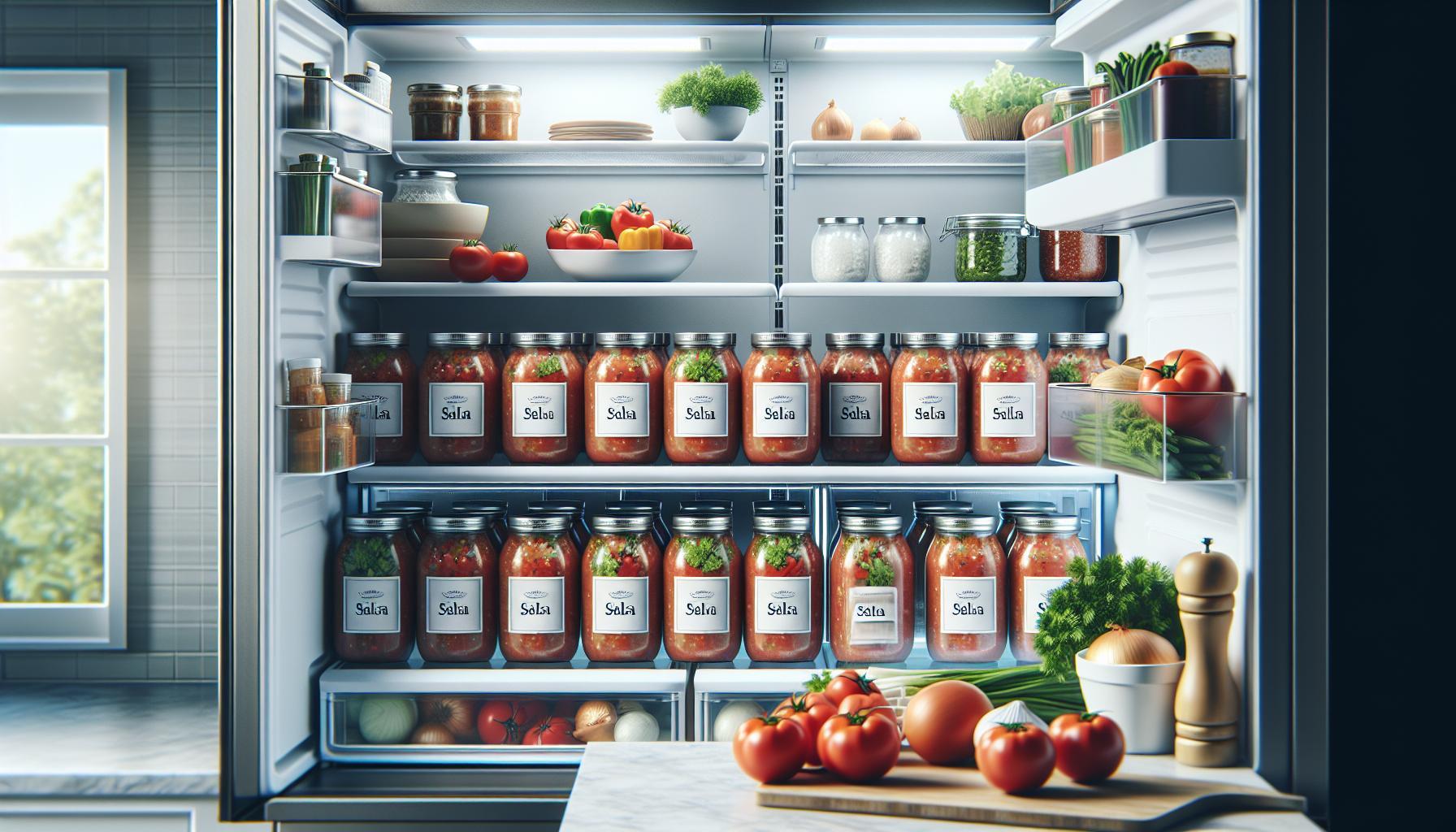Salsa is a beloved condiment, but many people wonder how long an opened jar can last in the fridge before it goes bad. Knowing the shelf life of open salsa is essential for preventing food waste and ensuring food safety. In fact, properly stored salsa can last up to two weeks, but various factors influence its longevity, including ingredients and packaging.
Understanding these aspects can help you make informed decisions about your food storage practices. Whether you’re entertaining guests or simply enjoying a snack at home, learning to keep your salsa fresh allows you to savor every last drop without the worry of spoilage. Continue reading to discover tips on storage, signs of spoilage, and how to extend the life of your opened salsa, ensuring you make the most of this flavorful addition to your meals.
How Long Does Open Salsa Last in the Fridge?
When it comes to enjoying salsa, whether homemade or store-bought, understanding its shelf life once opened is crucial for food safety and minimizing waste. Generally, an opened jar of salsa can last about 5 to 7 days in the refrigerator if stored properly. However, some commercially prepared salsas might remain safe to consume for up to two weeks, thanks to added preservatives. It’s important to check the product’s label, as specific expiration dates can vary across brands.
To maximize the freshness of opened salsa, ensure it’s kept in an airtight container, preferably with minimal exposure to air. This helps to slow down the growth of bacteria and mold. Always use a clean spoon when serving to avoid contamination. Remember to keep the salsa stored in the fridge at a consistent temperature below 40°F (4°C).
While the time frames mentioned can serve as general guidelines, the best approach is to trust your senses. If the salsa develops an off smell, noticeable mold, or changes in texture, it’s best to err on the side of caution and discard it. Keeping an eye on freshness not only ensures your safety but also enhances your culinary experience when savoring your favorite dips and toppings.
Understanding Salsa Shelf Life: Key Factors
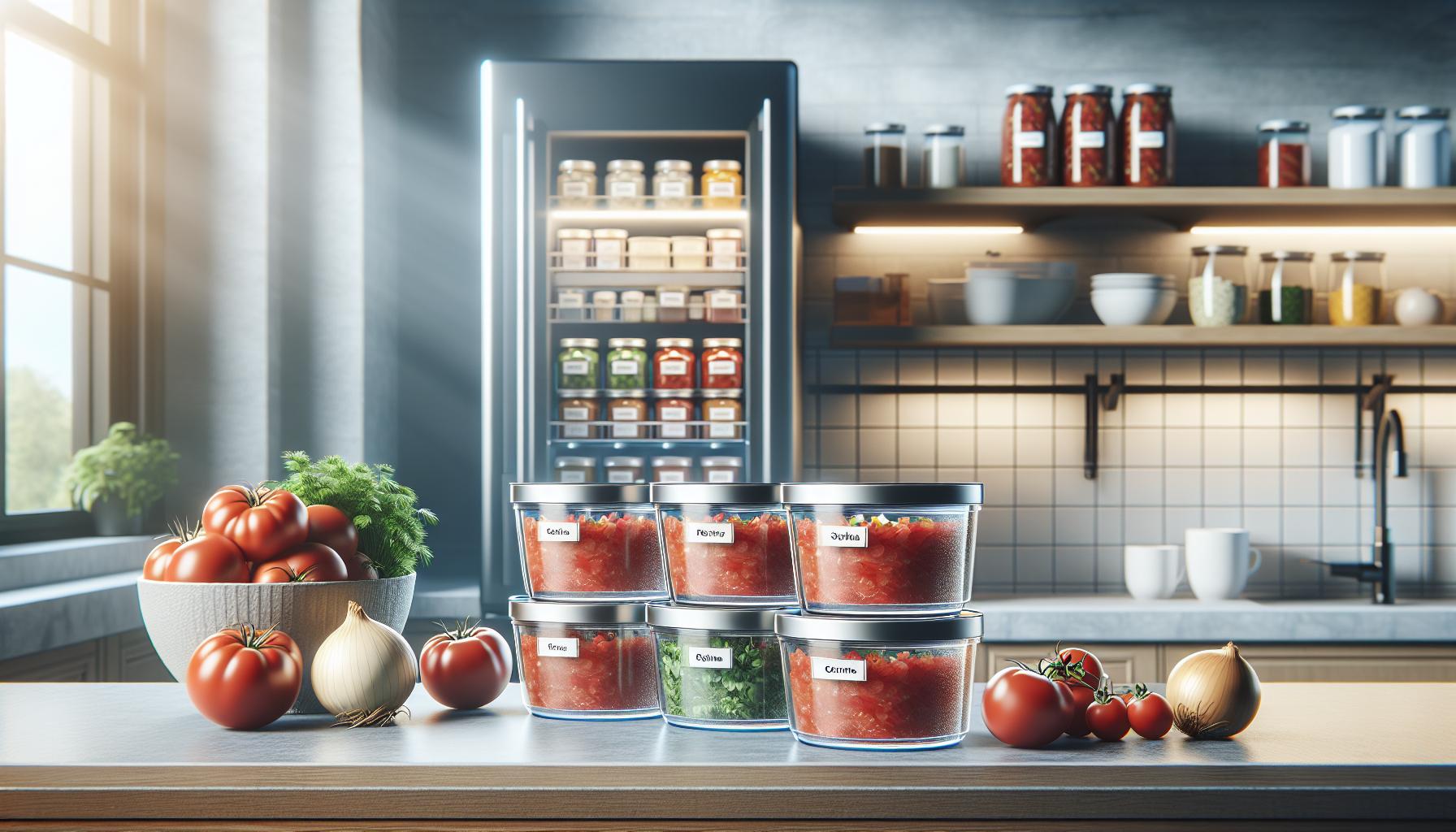
Understanding the longevity of opened salsa hinges on several key factors that can impact its freshness and safety. The primary influences include the salsa’s ingredients, storage conditions, and the presence of preservatives. Typically, homemade salsas, often composed of fresh vegetables and herbs, have a shorter lifespan compared to their store-bought counterparts, which may contain added chemicals that extend their shelf life.
The ingredients used in salsa play a critical role in its durability. For instance, salsas that include high-acid components such as tomatoes and vinegar generally have a better shelf life, as these environments can inhibit bacterial growth. Conversely, fresh salsa made with delicate ingredients like avocados or cream will spoil more rapidly. In terms of storage, maintaining a consistent refrigerator temperature below 40°F (4°C) is crucial, as fluctuations can accelerate spoilage.
Furthermore, storage methods significantly affect salsa’s viability. Keeping salsa in an airtight container minimizes exposure to air and light, both of which can promote deterioration. Additionally, always using clean utensils when serving salsa helps prevent contamination that can lead to faster spoilage. Regularly checking for any off smells, discolorations, or mold is essential, as these are telltale signs that the salsa has outlived its freshness. By being mindful of these key factors, you can effectively optimize the shelf life of your opened salsa, reducing waste and ensuring a safe culinary experience.
The Importance of Proper Storage Techniques

Ensuring salsa stays fresh and safe for consumption is largely dependent on the methods used for its storage. Improper techniques can significantly shorten its shelf life, leading to unnecessary waste. Whether you’re savoring a homemade batch or a store-bought variety, understanding the importance of effective storage can help maximize your salsa’s longevity.
To start, always transfer your opened salsa into an airtight container if it isn’t already packaged that way. This simple step minimizes exposure to air, which can introduce bacteria and cause oxidation, both contributing to spoilage. It also protects the salsa from moisture and other cross-contamination from the refrigerator. Ideally, store salsa in the coldest part of the fridge, not in the door, where temperatures fluctuate more.
Another critical aspect of storage is cleanliness. Use clean utensils every time you serve salsa to avoid introducing contaminants. Even small quantities of leftover salsa can harbor harmful bacteria if tainted by dirty spoons or hands. Additionally, it’s good practice to label your salsa containers with the date of opening-this way, you can easily keep track of freshness. Generally, opened salsa will remain edible for about 5 to 7 days in the refrigerator.
Key Storage Guidelines
- Use Airtight Containers: Transfer salsa to an airtight container upon opening to reduce air exposure.
- Keep it Cold: Store salsa in the coldest part of the fridge, maintaining a temperature below 40°F (4°C).
- Maintain Cleanliness: Always use clean utensils to serve salsa and avoid contamination.
- Label and Date: Mark containers with opening dates to monitor how long they’ve been stored.
By implementing these simple yet effective storage techniques, you can ensure that your opened salsa remains delicious and safe to enjoy for its intended shelf life, significantly reducing food waste and enhancing your culinary experiences.
Signs Your Salsa Has Gone Bad
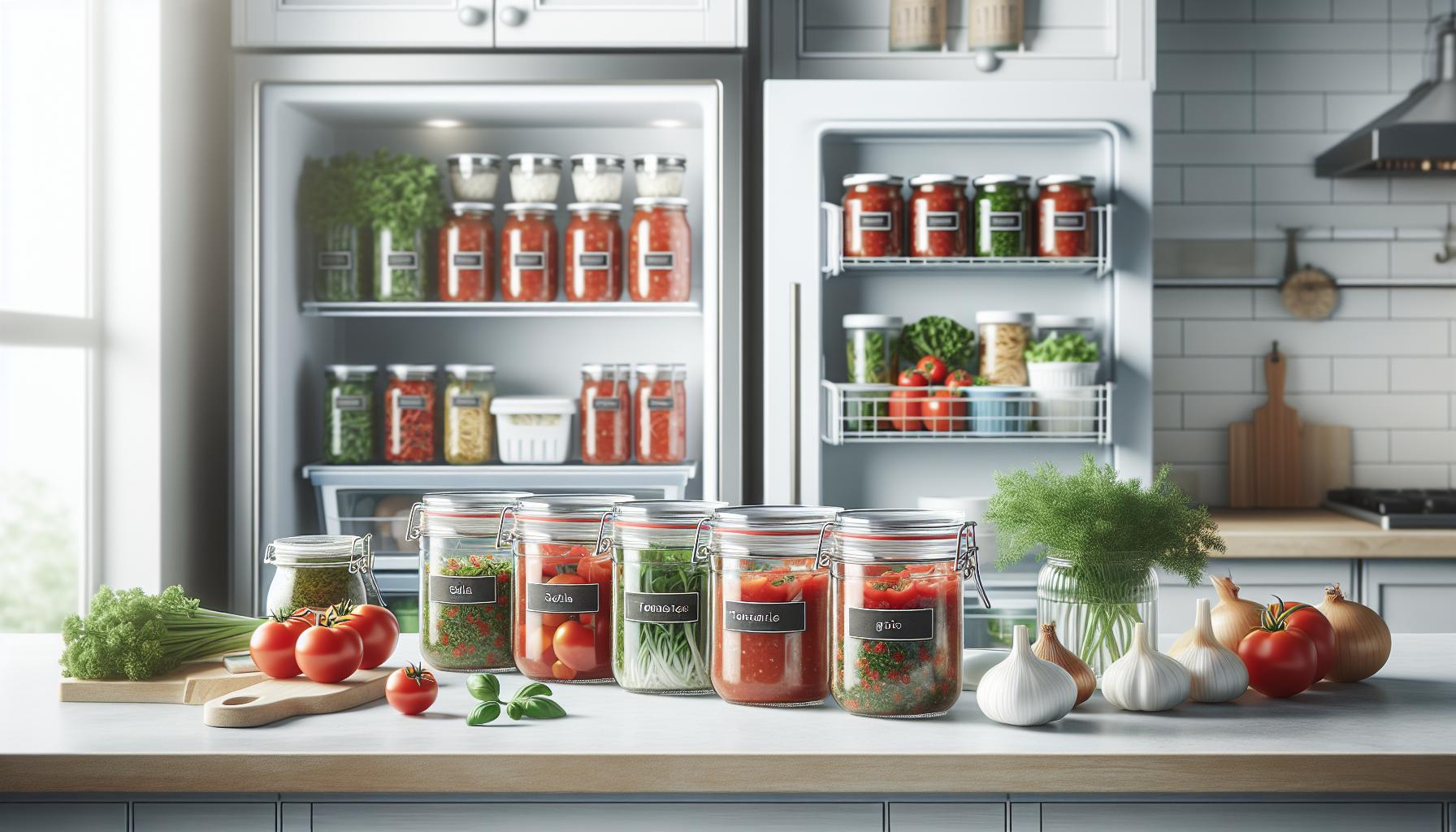
When it comes to enjoying salsa, knowledge about signs of spoilage can help prevent food waste and protect your health. Whether it’s a homemade batch or a jar from the store, several indicators can signal that salsa has become unsafe to eat. Keeping an eye out for these changes allows you to make informed decisions about whether to keep or toss your salsa.
A thorough visual inspection is crucial. Check for any significant changes in color-fresh salsa typically has a vibrant look, while spoiled salsa may appear dull or have dark spots. Separation of liquid is another red flag. If you notice excessive liquid pooling at the bottom, it could indicate decomposition. Additionally, mold growth is a clear sign that your salsa is no longer safe to consume. Even a small spot of mold means it’s best to discard the entire container, as mold can penetrate beyond what is visible.
Smell plays a central role in determining freshness, too. Opening your salsa should greet you with a pleasant blend of spices and fresh ingredients. A sour or off-putting odor is a clear indication that the salsa has spoiled, and it should be immediately discarded. Textural changes are also noteworthy; if your salsa appears overly mushy or has developed a slimy consistency, it’s time to let it go.
Finally, if you’re approaching the 5 to 7-day mark since opening it, and you have any doubts about its quality, it’s prudent to err on the side of caution. Always remember that when it comes to food safety, it’s better to be safe than sorry. Proper awareness of these signs helps you maximize your culinary experience while minimizing unnecessary waste.
Maximizing Salsa Freshness: Tips and Tricks
To keep your salsa at its freshest and most flavorful, understanding how storage conditions impact its longevity is key. Freshly made or opened salsa can last approximately 5 to 7 days in the refrigerator, but there are specific steps you can employ to maximize its shelf life. One of the most effective techniques is to store salsa in an airtight container. This limits exposure to air, which can accelerate spoilage. Additionally, using glass containers instead of plastic can also help retain freshness, as glass is less permeable to odors and can help prevent bacterial growth.
It’s also beneficial to consider the temperature of your refrigerator. Keeping your salsa in the coldest part of the fridge, typically towards the back, may help ensure it stays fresh longer. Avoid storing salsa on the fridge door, as frequent temperature changes can negatively impact its quality. If you frequently make your own salsa, try to portion it into smaller containers. This way, you can minimize the number of times you open a single container, further preserving the balance of flavors and quality.
When using leftover salsa, always utilize clean utensils to scoop it out. This minimizes the risk of contamination, which can lead to spoilage. If you’ve noticed that your salsa is nearing its expiration time, consider repurposing it in various dishes. From topping grilled meats to enhancing soups or stews, using leftover salsa creatively can reduce food waste while keeping your meals exciting. By following these practical tips, you can enjoy your salsa longer without compromising quality.
Comparing Salsa Varieties: Duration and Storage Needs
When it comes to salsa, the diversity of ingredients creates variations in shelf life and storage requirements that every home cook should consider. From fresh pico de gallo to cooked or canned varieties, understanding these differences can help you minimize waste and keep your salsa at its best.
Fresh Salsa
Fresh salsa, often made with a combination of tomatoes, onions, cilantro, and peppers, usually lasts about 5 to 7 days in the fridge after opening. To ensure maximum freshness, always store it in an airtight glass container, as this reduces exposure to air and slows spoilage. Keep fresh salsa towards the back of your fridge where the temperature is more consistent.
Cooked or Canned Salsa
On the other hand, cooked or commercially canned salsa can last significantly longer-typically from 1 to 2 weeks once opened. These salsas often contain preservatives that extend their shelf life. However, proper storage practices remain essential; after opening, it’s best to refrigerate them promptly and use a clean utensil to scoop out portions.
Chunky vs. Smooth Salsa
Another consideration is the texture of the salsa. Chunky salsas may have a shorter lifespan compared to smoother varieties due to their higher moisture content and increased surface area for spoilage. For instance, a chunky fresh salsa may be best consumed within the first five days, while a smooth salsa with fewer vegetables might remain good for a week or slightly longer.
Understanding these nuances can empower you to make informed decisions about your salsa storage, ultimately reducing food waste. By selecting the appropriate storage containers, monitoring the time since opening, and adapting your use of leftover salsa, you’ll be able to enjoy this flavorful staple longer while minimizing potential spoilage.
The Science Behind Food Preservation
Preservation of food is a fascinating interplay of science and art, particularly evident in salsa, which blends fresh ingredients with flavors and textures. Microbial growth, oxidation, and moisture levels are pivotal factors that affect how long an opened container of salsa remains safe and delicious. Understanding these elements not only helps maintain food safety but also maximizes flavor, texture, and nutritional value, ultimately contributing to a decrease in food waste.
Microbial Growth
One of the primary concerns in food preservation is the growth of bacteria, molds, and yeasts. Fresh salsa, often rich in moisture because of its tomato and onion content, creates an environment where these microorganisms can thrive if not stored properly. Refrigerating opened salsa slows down this microbial activity significantly, but salsa typically only lasts about 5 to 7 days in the fridge due to the delicate nature of its ingredients. Cooked or canned varieties, with their added preservatives, can generally withstand 1 to 2 weeks, allowing for more flexibility with storage times.
Oxidation and Temperature Control
Oxidation, which can lead to spoilage and off-flavors, is another key factor to consider. This process is exacerbated when salsa is exposed to air. Storing salsa in small, airtight containers helps minimize this exposure, effectively slowing down oxidation. Ambient temperature also plays a critical role; keeping salsa in the colder back section of the refrigerator, where the temperature is most stable, can extend its shelf life even more.
Moisture and Texture
The moisture content in salsa further influences its shelf life. Chunky salsas tend to have higher moisture levels, increasing the likelihood of spoilage compared to smoother salsas. By opting for a variety with fewer vegetables or by controlling serving sizes and minimizing air exposure, you reduce the risk of premature spoilage.
By understanding these scientific principles of food preservation, you can make informed choices about safe salsa storage. This knowledge not only enhances your culinary experience but also plays a crucial role in reducing food waste, ensuring you enjoy your homemade or store-bought salsa at its peak freshness.
Creative Uses for Leftover Salsa
Leftover salsa presents a fantastic opportunity to elevate your meals while minimizing food waste. Instead of letting that half-empty jar languish in the fridge, consider these creative and delicious ways to incorporate it into your kitchen routine. With its zesty flavors and vibrant ingredients, salsa can transform everyday dishes into exciting culinary experiences.
One of the simplest ways to use leftover salsa is to stir it into scrambled eggs or an omelet. This not only enhances the taste but also adds nutrients from the fresh vegetables and herbs. You can also use salsa as a marinade for grilled chicken or fish. Just coat your protein of choice and let it sit for at least an hour before cooking to allow the flavors to meld, resulting in a juicy and flavorful meal.
Salsa can also be the star ingredient in soups and sauces. Simply add a scoop to your favorite chili recipe or mix it into a pot of simmering beans for extra flavor. If you’re feeling adventurous, blend leftover salsa with some cream cheese or Greek yogurt to create a tasty dip for chips or veggies. This transformation not only revitalizes the salsa but also gives you a fresh and healthy snack option.
For those who often cook pasta, consider tossing some salsa into a skillet with sautéed vegetables or meat for a quick pasta sauce. The fresh taste of salsa can brighten up a simple dish like spaghetti or provide a delightful twist to tacos or burrito bowls. By being resourceful and applying a little creativity, you can ensure that no jar of salsa goes to waste while adding new and exciting flavors to your meals.
Best Practices for Freezing Salsa Safely
Freezing salsa can be a game-changer when it comes to extending the life of this flavorful condiment. Many people may not realize that salsa can be safely frozen for later use, which can help reduce food waste and keep your kitchen stocked with tasty options. When freezing salsa, the key is to maintain its texture and flavor, while ensuring it remains safe to eat.
To begin, choose a suitable container for your salsa. Freezer-safe glass containers, plastic storage containers, or resealable freezer bags can all be effective. If using freezer bags, lay them flat in the freezer, as this will save space and allow the salsa to freeze more evenly. Remember to leave about an inch of headspace in the container or bag, as salsa will expand when frozen. Label your containers with the date to keep track of freshness, and aim to consume frozen salsa within 2 to 3 months for optimal flavor.
When it’s time to thaw your salsa, the safest method is to transfer it from the freezer to the fridge a day in advance. This slow thawing allows the salsa to retain its original texture and flavor. If you’re in a hurry, you can also thaw the sealed salsa in a bowl of cold water, changing the water every 30 minutes until it’s fully thawed. Avoid thawing salsa in the microwave, as it can suffer from uneven heating, leading to undesirable texture changes.
Keep in mind that while freezing preserves the salsa, it may alter the texture slightly due to the water content in fresh ingredients like tomatoes and onions. For best results, consider using thawed salsa in cooked dishes, such as soups, stews, or as a topping for baked casseroles, where any textural differences will be less noticeable. By following these best practices for freezing salsa, you’ll ensure that you have a delicious, convenient addition to your meals, while effectively reducing food waste.
Eco-Friendly Tips to Reduce Food Waste
Keeping salsa fresh not only enhances your meals but also minimizes waste, an increasingly crucial aspect in today’s environmentally conscious world. Open salsa can typically last in the fridge for about 5 to 7 days if stored properly. However, there are strategic methods you can adopt to extend its usability and reduce food waste significantly.
To optimize the lifespan of your salsa, consider repackaging it into smaller containers immediately after opening. This limits exposure to air and contaminants each time you open the main container. Use airtight containers or resealable bags to keep moisture and air at bay. Additionally, always use clean utensils when scooping out salsa; this will help prevent introducing bacteria that can lead to spoilage.
When you find yourself with leftover salsa nearing its expiry, get creative! Integrate it into various dishes such as marinades, soups, or as a topping on baked potatoes or grilled meats. Think outside the box-salsa can even be used in salad dressings or as a flavor booster in pasta dishes. If you’re serious about reducing waste, consider freezing your salsa as a last resort, ensuring that it is consumed within 2 to 3 months for the best quality.
Lastly, regular pantry audits can help keep bad inventory in check. If you consistently find your salsa going bad before use, experiment with portion sizes when purchasing or reevaluate recipes where salsa plays a pivotal role. Being proactive about what’s in your fridge and adjusting your buying habits will further help you reduce food waste, ultimately leading to a more sustainable kitchen.
How to Safely Dispose of Expired Salsa
When the reality of expired salsa sets in, it’s imperative to understand the proper way to dispose of it to maintain kitchen safety and hygiene. Expired salsa can develop harmful bacteria that pose health risks, making careful disposal essential. If your salsa has surpassed its recommended storage time-typically 5 to 7 days in the refrigerator-it’s best to stop and check for signs of spoilage like off odors, strange colors, or unusual textures.
To safely dispose of expired salsa, start by placing the container inside a plastic bag to prevent leaks. This additional layer protects your kitchen from potential contamination. Seal the bag tightly before placing it in your indoor trash bin, ensuring no residual liquids can escape. If you have a compost bin, remember that salsa contains ingredients like onions and tomatoes which may not be suitable for compost. Instead, rely on your regular trash. For those concerned about environmental impact, check if your local waste management has an organic waste collection program where safe food products can be composted responsibly.
Best Practices for Disposal
- Check for spoilage: Ensure the salsa is visibly spoiled before disposal.
- Seal securely: Use a plastic bag to contain spills and odors.
- Dispose of in regular trash: Keep expired salsa out of compost to avoid contaminating your compost heap.
- Consider community programs: Seek local food waste recycling options for safe disposal.
By following these guidelines, you not only prioritize your health but also contribute to maintaining a clean kitchen environment. Ignoring proper disposal methods can lead to not only unpleasant odors but also unwanted pests. Taking a few minutes to dispose of expired salsa correctly ensures your cooking space remains safe and inviting.
Exploring Homemade Salsa Storage Solutions
Storing homemade salsa properly is essential to maximize its freshness and minimize food waste. Once opened, homemade salsa typically lasts in the refrigerator for about 5 to 7 days. However, how you store it can significantly affect its shelf life. To keep your salsa enjoyable for as long as possible, follow these storage solutions and practices.
First, always transfer your salsa to an airtight container if it isn’t already in one. Glass jars with tight-fitting lids or BPA-free plastic containers are excellent options, as they prevent exposure to air and minimize the risk of bacteria growth. When sealing the container, press down gently to remove excess air, which can contribute to spoilage. Additionally, it’s best to store the salsa on a shelf directly in the fridge, rather than in the door, where temperatures can fluctuate more significantly.
For longer-term storage, consider freezing your salsa. Salsa can maintain its quality in the freezer for up to 3 months. To freeze, pour the salsa into freezer-safe bags or containers, leaving some headspace for expansion. Label each bag or container with the date and contents, so you remember what you have stored. When you’re ready to use it, thaw the salsa in the refrigerator overnight to preserve its texture and flavor.
Finally, being mindful of how you serve and handle the salsa can extend its life. Use clean utensils each time you dip into your salsa, as contaminants from fingers and serving spoons can introduce bacteria. If you notice any signs of spoilage, such as off odors or a change in color, it’s wise to discard the salsa to avoid any food safety risks. By implementing these straightforward storage practices, you can enjoy your homemade salsa safely and deliciously, while also reducing food waste and maximizing freshness.
Common Myths About Salsa Shelf Life
Many people are surprised to learn that salsa can be one of the more misunderstood condiments when it comes to shelf life and safety. Among the most prevalent myths is the belief that salsa lasts indefinitely once opened if stored in the refrigerator. In reality, while salsa can maintain its quality for several days, it typically only stays fresh for about 5 to 7 days after opening, regardless of whether it’s homemade or store-bought. This misconception often leads to food waste as consumers may inadvertently use salsa past its prime.
Another common myth is that because salsa contains ingredients like tomatoes and lime juice, which are known for their natural preservative qualities, it is immune to spoilage. However, even with these ingredients, salsa is still susceptible to bacterial growth when not handled or stored properly. For instance, leaving it uncovered or using contaminated utensils can introduce harmful bacteria, reducing the salsa’s shelf life significantly.
People also often assume that if salsa smells or looks fine, it is safe to eat. This can be deceptive, as spoilage can occur without overt changes. It’s crucial to trust your senses but also to rely on the recommended storage guidelines. Signs of spoilage can include off-odors, a change in texture, or visible mold; thus, when in doubt, it’s better to err on the side of caution and discard any salsa that raises concerns.
Understanding these myths not only helps in making informed decisions about food safety but also aids in reducing food waste. By recognizing the proper storage practices and adhering to a clear timeline for consumption, you can enjoy your salsa safely while minimizing unnecessary waste. Remember, the best way to keep salsa fresh for as long as possible is to store it in an airtight container and consume it within the recommended timeframe.
FAQ
Q: How can I tell if my open salsa has gone bad?
A: To determine if your open salsa has spoiled, check for an off smell, discoloration, or the presence of mold. If the salsa appears watery or has an unusual texture, it’s best to discard it. For more signs of spoilage, refer to the “Signs Your Salsa Has Gone Bad” section in the article.
Q: What is the best way to store open salsa?
A: Open salsa should be stored in an airtight container in the refrigerator to maintain freshness. Keeping it at a constant temperature and minimizing exposure to air helps prevent spoilage. For detailed storage techniques, see the “Importance of Proper Storage Techniques” section of our article.
Q: Can I freeze open salsa to extend its shelf life?
A: Yes, you can freeze open salsa to prolong its shelf life. Use a freezer-safe container and leave space for expansion. For safe freezing practices, check out the “Best Practices for Freezing Salsa Safely” section of the article.
Q: How long can homemade salsa last in the refrigerator?
A: Homemade salsa typically lasts about 5 to 7 days in the refrigerator if stored properly in an airtight container. For a deeper understanding of salsa shelf life, refer to the “Understanding Salsa Shelf Life: Key Factors” section.
Q: Is it safe to eat salsa after the expiration date?
A: Consuming salsa after the expiration date isn’t advisable, as it may pose food safety risks. Always inspect the salsa for spoilage signs before use, as discussed in the “Signs Your Salsa Has Gone Bad” section of the article.
Q: What should I do with leftover salsa to avoid waste?
A: Consider repurposing leftover salsa into other dishes like soups, marinades, or as a topping for proteins. For additional creative uses, refer to the “Creative Uses for Leftover Salsa” section of the article.
Q: How can I reduce food waste with leftover salsa?
A: To minimize waste, plan meals around leftover salsa usage, or freeze it for future recipes. Explore eco-friendly tips in our “Eco-Friendly Tips to Reduce Food Waste” section for more strategies.
Q: What types of salsa last the longest in the fridge?
A: Fresh salsas without preservatives typically have a shorter shelf life than commercial brands, which can last longer due to added preservatives. For a comparison, visit the “Comparing Salsa Varieties: Duration and Storage Needs” section of our article.
Insights and Conclusions
By keeping these storage guidelines in mind, you can enjoy your open salsa without the worry of food waste. Remember, opened salsa is best used within a week or two, depending on its ingredients and how it’s stored. For more tips on preserving your favorite condiments, check out our article on Easy Homemade Salsa Recipes for delightful ways to use up any leftover ingredients.
Curious about what else you can store in your fridge? Explore our Food Storage Basics guide to keep your kitchen organized and waste-free. Don’t forget to subscribe to our newsletter for trusted food safety tips and tasty recipes delivered straight to your inbox! Have questions or tips to share? Leave a comment below; we love hearing from you. Your culinary adventures are just beginning!

